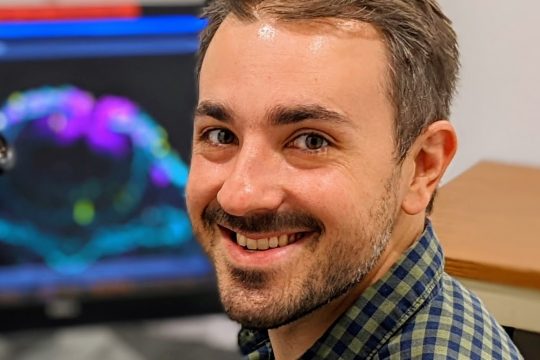Epithelial-to-mesenchymal transition (EMT) is a cellular lifestyle change that produces highly invasive cells that can migrate long distances in the body. These processes are critical for normal embryonic development but are often reactivated in disease states such as cancer...
Copper plays an essential role in human physiology. It serves as a cofactor to key metabolic enzymes that are required for respiration, neurotransmitter biosynthesis, detoxification of radicals, blood clotting, connective tissue formation, and many others processes. Through currently unknown...
Our laboratory’s research focuses on understanding (1) how cells measure levels of available nutrients and (2) how cells adapt to changes in nutrient supply to control metabolic homeostasis. Our studies have primarily centered on changes in cholesterol and oxygen...
Our laboratory studies the basic molecular mechanisms of programmed cell death, an evolutionarily conserved process to eliminate cells. Because these pathways normally contribute to the millions of cell deaths that occur per day per individual, defects in cell death...
Mechanisms of gradient sensing and chemotaxis are conserved in mammalian leukocytes and Dictyostelium amoebae. Both cells use G protein linked signaling pathways. PH domains specific for PtdIns(3,4)P2 and PtdIns(3,4,5)P3 bind to the membrane at the leading edge of the...
Research Focus Our research focuses on “synthetic cell biology” to dissect and reconstitute intricate signaling networks. In particular, we investigate positive-feedback mechanisms underlying the initiation of neutrophil chemotaxis (known as a symmetry breaking process), as well as spatio-temporally dynamic...
Our laboratory is interested in the area of sensory transduction: specifically visual and olfactory transductions, which are the processes by which the senses of vision and olfaction are initiated. These two processes have interesting similarities and differences. Vision can...
Phospholipids are the building blocks of biological membranes. Membranes leverage the amphipathic chemistry of lipids to form bilayers that encapsulate a cell and its multitude of organelles. Such compartmentalization has enabled cells to separate biochemical pathways, establish specialized functions...
My lab studies the cellular and molecular basis of synaptic transmission and plasticity. Neuronal signaling events at synapses determine circuit responses and result in specific behavioral outputs. This signaling is dynamic – modulated by synapse activity history and perceived...
Our work bridges from biochemical to preclinical translational studies to harness the power of glycobiology for therapeutic benefits. All cells are endowed with a diverse coat of glycans, their “glycocalyx,” which represents the face of the cell to the...










